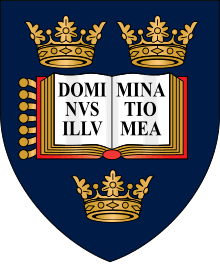St Catherine's College, Oxford
| St Catherine's College | ||||||||||||||||
|---|---|---|---|---|---|---|---|---|---|---|---|---|---|---|---|---|
| Oxford | ||||||||||||||||
|
| ||||||||||||||||
.svg.png) Blazon: Sable a saltire ermine between four catherine wheels or. | ||||||||||||||||
|
| ||||||||||||||||
| Location | Manor Road | |||||||||||||||
| Coordinates | 51°45′25″N 1°14′42″W / 51.757066°N 1.245098°WCoordinates: 51°45′25″N 1°14′42″W / 51.757066°N 1.245098°W | |||||||||||||||
| Motto | Nova et Vetera (The New and the Old) | |||||||||||||||
| Established | 1962 | |||||||||||||||
| Named for | St Catherine of Alexandria | |||||||||||||||
| Previous names | Delegacy of Unattached Students, Delegacy of Non-Collegiate Students, St Catharine's Club, St Catherine's Society | |||||||||||||||
| Sister college | Robinson College, Cambridge | |||||||||||||||
| Master | Roger Ainsworth | |||||||||||||||
| Undergraduates | 497[1] (December 2017) | |||||||||||||||
| Postgraduates | 409[1] (December 2017) | |||||||||||||||
| Website |
stcatz | |||||||||||||||
| Map | ||||||||||||||||
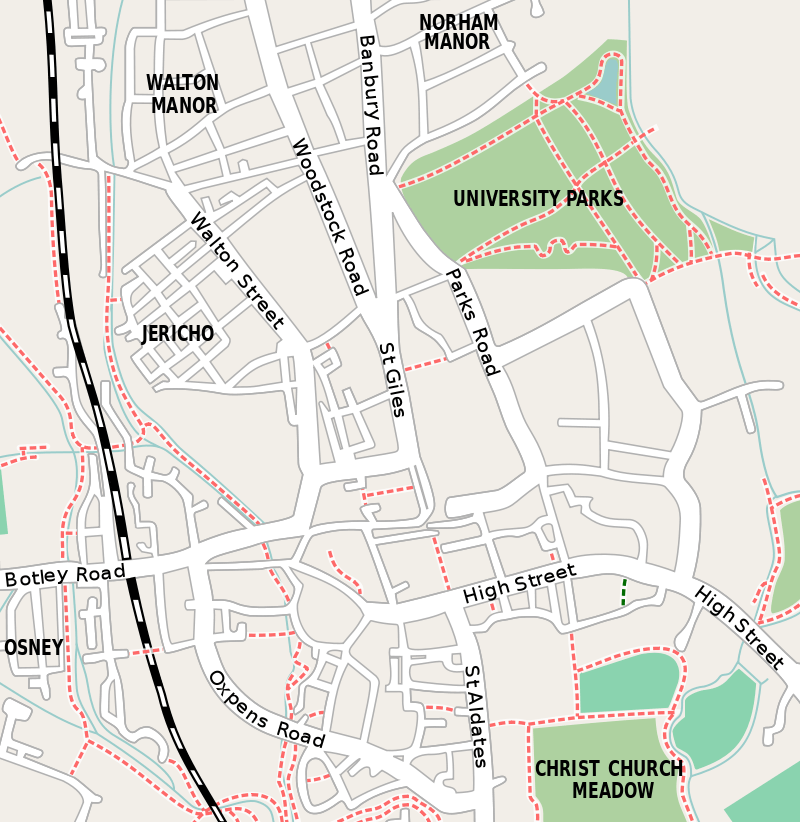 Location in Oxford city centre | ||||||||||||||||
St Catherine's College (often called Catz by college members) is one of the constituent colleges of the University of Oxford in England. Its motto is Nova et Vetera, which translates as: "Things both new and old".
St Catz is the University of Oxford’s newest mixed college and also one of the largest. It developed out of the St Catherine's Society, and was founded in 1962 by the historian Alan Bullock, who went on to become the first Master of the college, and later Vice-Chancellor of Oxford University. As of 2015, the college had an estimated financial endowment of £73.3m.[2]
History
The college traces its descent from the Scholares Non Ascripti, or Delegacy of Non-Collegiate Students, founded by Statute on 11 June 1868[3]. This was established as part of an expansion of the University so that students would be able to gain an Oxford education without the costs of college membership[4]. During the academic year 2018/2019, the College will therefore be celebrating its 150th Anniversary, in recognition of these origins.
The delegacy was originally headed by two Censors, George W. Kitchin and George S. Ward, who oversaw the administration and welfare of the students.[5] Nineteen students matriculated in October 1868 as Scholares Non Ascripti and were joined throughout the year by another forty, bringing the total number in the first year to fifty-nine.[6] By 1914, more than 4,000 men had matriculated as Non-Collegiate students.[7] The Delegacy students met socially as St Catherine's Club (originally St Catharine's Club) from 1874, which was named after its meeting place in a hall on Catte Street.[8] The club was officially recognised by the University in 1931 as St Catherine's Society. It was thus developing the characteristics of a college, and in 1956 the Delegates decided to formalise this change in status.[9]
After acquiring 8 acres (3.2 ha) from Merton College, Oxford on part of Holywell Great Meadow for £57,690, monies were sought from the University Grants Committee who also agreed to supply £250,000 towards the building, and additional funds up to £400,000 for all facilities. By 1960 Sir Alan Bullock raised a further £1,000,000 with invaluable assistance from two industrial notables, Sir Alan Wilson (whom he met by chance on the RMS Queen Mary) and Sir Hugh Beaver. After a total cost of £2.5 million, the college opened in 1962 to male students. In 1974 St Catz was one of the first men's colleges to admit women as full members, the others being Brasenose, Jesus College, Hertford and Wadham.[10]
Buildings
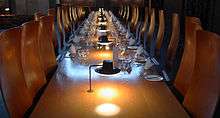
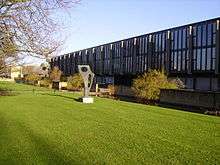
The college is situated towards the east of Oxford, on the bank of the Cherwell river. Its striking buildings in glass and concrete by the Danish architect Arne Jacobsen marry modern materials with a traditional layout around a quadrangle. Jacobsen's designs went further than just the fabric of the buildings, with cutlery, furniture, and lampshades being of his own idiosyncratic design. The dining hall is notable for its Cumberland slate floor.
The original college buildings received a Grade I listing on 30 March 1993.[11] Jacobsen's plans for the college did not include a chapel: St Cross Church on the corner of Manor Road and Longwall Street used to serve this purpose when required before its decommission in the Autumn of 2008. The St Catherine's Christmas carol concert has since been held in Harris Manchester College's chapel. The college has a bell tower however; it is particularly visible since no college building is more than three storeys high. An extra floor was reputedly planned for most accommodation blocks, but due to regulations concerning safe building on marshland, this was removed from the final design.
St Catherine's has a number of lecture theatres and seminar rooms, a music house, two student computer rooms, a small gym, squash courts, a punt house, and among the most spacious common rooms in Oxford. There are also additional purpose-built conference facilities with lecture theatres, meeting rooms and bar, and car parking available for non-students. The dining hall, which seats 350 diners, has the largest capacity of any Oxford college.[12]
Accommodation
The majority of St Catherines' buildings are in the form of 'staircases' that open directly onto the quad(s) outside; these are filled with student rooms and office space. There is little indoor space in the college and St Catherines favours a minimalist, rather austere environment, though still comfortable. Student rooms are light and spacious, notable for their 'curtain wall' glazing.
In 1994 and 2004, the college completed construction of three and seven new accommodation staircases designed by Hodder and Partners with en-suite rooms, which means that most undergraduates can live on the main college site for the duration of their course. Prior to this, all undergraduates had the experience of living off-campus for their second year. These new staircases effectively form a second quad, which is largely used to provide accommodation for conferences during the breaks between academic terms.
Student life
The college celebrates its patron saint each year with a special Catz Night dinner, attended by junior and senior members of the college. Every three years the college also holds a ball, usually off-site due to the problem of securing the college's perimeter sufficiently for insurance purposes.
The Wallace Watson Award is a travel scholarship granted annually to a student or group students to undertake an expedition in a remote region of the world.
Academic reputation
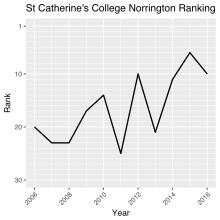
In 2018, St Catherine's College ranked 3rd on the Norrington Table, with a score of 78.15%, climbing from 26th place in 2017 when it had a score of 68.68%. [13]
Rowing
St Catherine's College Boat Club is the rowing club of the college. In Torpids 2012, the men's first boat was fourth on the river and then were bumped three times, ending seventh. The first boat was then ninth on the river after being bumped in the Summer Eights.[14] The women's first boat held headship in Torpids a few years ago. In 2017, however, the women's boat managed to score an unprecedented −10 bumps (due to hitting a tree).[15] British Olympic gold medallists Sir Matthew Pinsent and Andrew Triggs Hodge, and silver medallist Colin Smith all rowed for the college.
Notable alumni
Notable fellows
List of masters
- 1969–1981: Alan Bullock; first master
- 1981–1988: Patrick Nairne
- 1988–1994: Brian Smith
- 1994–2000: Raymond Plant, Baron Plant of Highfield
- 2000–2002: Sir Peter Williams
- 2002–present: Roger Ainsworth
Gallery
- A view of the quad at night.
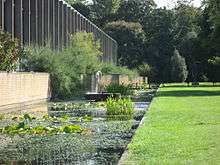 A view of the water garden along the west side of the site, toward the small bridge that was part of the original entrance sequence.
A view of the water garden along the west side of the site, toward the small bridge that was part of the original entrance sequence.- A view of the west-side accommodation and water garden.
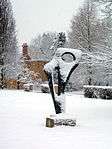 The statue outside the old porter's lodge in snow, "Achaean" by Barbara Hepworth.
The statue outside the old porter's lodge in snow, "Achaean" by Barbara Hepworth. Barbara Hepworth's "Achaean" at St Catherine's College, Oxford.
Barbara Hepworth's "Achaean" at St Catherine's College, Oxford.
References
- 1 2 "Student numbers". University of Oxford. Retrieved 3 April 2018.
- ↑ http://d307gmaoxpdmsg.cloudfront.net/collegeaccounts1516/St_Catherines.pdf
- ↑ Stat. Tit. II. Sect. II. Cl. I Addenda ad Corpus Statutorum Universitatis Oxoniensis p.754 https://books.google.co.uk/books?id=wT0JAAAAQAAJ&pg=PA754#v=onepage&q=nisi%20qui%20in%20aliquod%20collegium&f=false
- ↑ http://www.stcatz.ox.ac.uk/College-History. Retrieved 19/01/18.
- ↑ Trotman, R.R. & Garrett, E.J.K. The Non-Collegiate Students and St Catherine’s Society 1868–1962 (Oxford University Press, 1962)
- ↑ Report of the Delegati ad aedes licentiandas, (Oxford, June 1869)p.6-7
- ↑ Bullock, A. 'The history of the University of Oxford. Vol. 7, Nineteenth-century Oxford. Part 2 (eds. M.G. Brock & M.C. Cuthoys), Ch. 7 p.207
- ↑ http://www.oxfordhistory.org.uk/broad/buildings/east/hertford/29.html. Retrieved 19/01/18
- ↑ "College History". St. Catherine's College, Oxford website. Archived from the original on 9 November 2006. Retrieved 13 May 2007.
- ↑ "Women at Oxford". University of Oxford. Retrieved 12 June 2016.
- ↑ "Listed Buildings Online – St Catherines College, Podium And All Buildings Upon It". Heritage Gateway. Retrieved 16 September 2008.
- ↑ "Buildings and Grounds – www.stcatz.ox.ac.uk". University of Oxford. Retrieved 3 April 2018.
- ↑ Ashworth, James. "St John's Tops The 2018 Norrington Table". The Oxford Student. The Oxford Student. Retrieved August 20, 2018.
- ↑ "Oxford University Rowing Clubs bumps charts". Retrieved 29 September 2012.
- ↑ "Oxford University Rowing Clubs bumps charts".
- Davies, M. & D. Creating St Catherine's College. Oxford: St Catherine's College, 1997. ISBN 0-9531279-0-7.
External links
| Wikimedia Commons has media related to St Catherine's College, Oxford. |
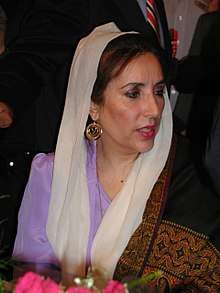


.jpg)

